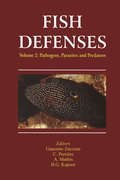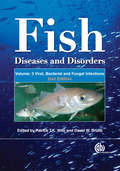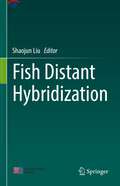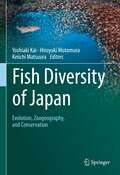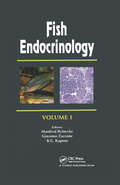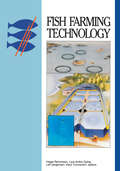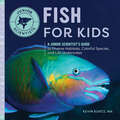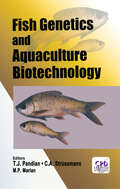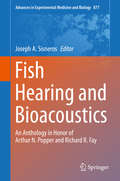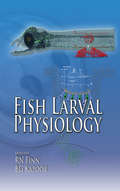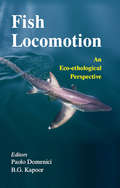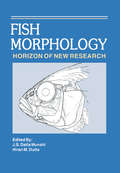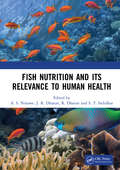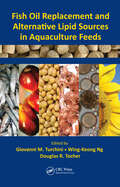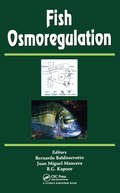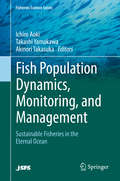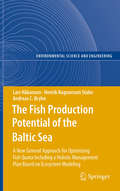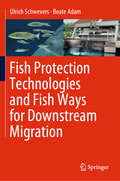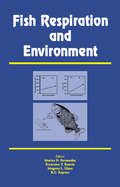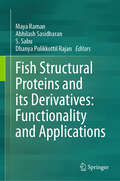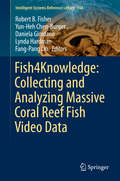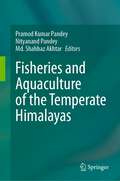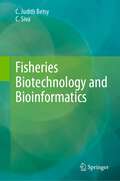- Table View
- List View
Fish Defenses Vol. 2: Pathogens, Parasites and Predators
by Giacomo ZacconeDramatic changes in the environment, including habitat degradation and climate change, have focused attention on how individuals and populations respond to a shifting biotic and abiotic landscape. A critical step toward meeting this goal is a clear understanding of the capacity of individuals to defend themselves against threats. Changes in water q
Fish Diseases and Disorders, Volume 3: Viral, Bacterial and Fungal Infections (2nd edition)
by Patrick T. K. Woo David W. BrunoThis third and final volume in the acclaimed Fish Diseases and Disorders trilogy addresses infectious diseases of finfish and shellfish caused by viruses, bacteria and fungi. Topics covered include infectious pancreatic necrosis virus, infectious hematopoiectic necrosis virus, viral diseases of cold- and warm-water fish, rickettsial and chlamydial infections, furunculosis, motile aeromonads, vibriosis, flavobacterial diseases and shellfish diseases. Written by experts in each discipline and updated throughout to reflect new developments in the field, including new chapters on alphaviruses, oncogenic viruses and genomics and proteomics, this is a must-have reference for fish health specialists and veterinarians, microbiologists, zoologists and researchers, and students in aquaculture.
Fish Distant Hybridization
by Shaojun LiuThe book introduces fish distant hybridization, which covers the basic theory and applications of fish distant hybridization as well as the main biological characteristics of different ploidy fish at the individual, tissue, cell, and molecular level. It is divided into 12 Chapters. The research progresses of animal distant hybridization and polyploids in domestic and overseas are summarized in this book. The characteristics of these hybrids and polyploid fish are also illustrated on basis of considering factors of the chromosomes numbers, phylogenetic relationship, reproduction, appearance, feeding habits, growth rate, and stress resistance. The creation of fish distant hybridization lineages will provide a clear genetic background which is helpful for the study of the strain generation as a model in genetic variation characteristics and reproductive characteristics. Fully illustrated in color, this book provides unique ideas in system description and presentation of distant hybridization and polyploidy fish. In fish genetic breeding, the tetraploid fish lineage and diploid fish lineage, formed through distant hybridization, can be used for preparing large-scale triploid and diploid fish. This book is a useful reference for researchers in fish genetic breeding, aquaculture, developmental biology, and animal evolution, and serves as a valuable resource for students and researchers engaging in zoology, evolutionary biology, and genetics.
Fish Diversity of Japan: Evolution, Zoogeography, and Conservation
by Yoshiaki Kai Hiroyuki Motomura Keiichi MatsuuraThis book reviews and summarizes the studies on the fish diversity of Japan. It covers the present knowledge of ichthyofauna, habitat distribution, phylogeography, ecology, morphology, and conservation, as well as the history of ichthyology and fish collections in Japan. The book comprises five parts: I. Fish Diversity and Ichthyology of Japan, II. Habitat Distribution and Species Diversity, III. Diversity within Species: Phylogeographic Perspective on Japanese Fishes, IV. Morphological and Ecological Diversifications, and V. Conservation of Fish Diversity in Japan. The Japanese Archipelago is surrounded by two major warm and one cold currents. It is located in the western North Pacific and encompasses several climatic regimes from north to south. Although the land area of Japan is small, the Exclusive Economic Zone (EEZ) of Japan ranks as the sixth largest in the world, including several marginal seas (Sea of Okhotsk, Sea of Japan, and East China Sea), and deep trenches (Izu-Ogasawara, Japan, and Kurile Trenches). Owing to a variety of marine habitats and a complex geological history, Japan has a rich fish species diversity, representing over 4,500 species in 370 families. The richness of fish species diversity has attracted many scientists since the late 1700s, and continuous studies have led to the development of ichthyology in Japan. With chapters written by leading experts in the field, the book will provide a stimulating and reliable resource for future research and contribute to the progress of ichthyology of the world.
Fish Endocrinology (2 Vols.)
by Giacomo Zaccone B. G. Kapoor Manfred ReineckeDuring the past two decades, fish endocrinology has witnessed exciting developments due to our increased knowledge at all levels of biological organizations, including molecular biology, cell biology, physiology and behavior. New insights into development, neurobiology, immunology and molecular genetics closely correlated with classical aspects of
Fish Farming Technology
by H. Reinersten L.A, Dahle L. JorgensenOver the past few years, it has become more and more obvious that fish farming will become increasingly important in the future. As fish farming moves into its industrial phase, technology will be an important factor in determining its successful development. It is therefore important for scientists & representatives from the aquaculture industry to meet to define state of the art and explore future development of fish farming technology for different fish species. 81 papers and abstracts were presented at the conference. The proceedings reflect the different sections of the conference: the plenum sessions and three parallel sessions: Juvenile marine fish, open production plants, closed production plants and poster sessions.
Fish for Kids: A Junior Scientist's Guide to Diverse Habitats, Colorful Species, and Life Underwater (Junior Scientists)
by Kevin Kurtz MASplash into the incredible world of fish with the Junior Scientists series for kids ages 6 to 9 Get up close and personal with the fascinating fish that live all around the world. Fish for Kids is full of colorful photos and illustrations that help you explore 35 different species, from goldfish and neon tetras to eels and great white sharks! Interactive learning—Unlike other fish books for kids, this one features hands-on activities and tips for going fishing or keeping your own aquarium. Fun facts—Learn how fish use camouflage, how they find food, and which fish can swim almost 70 miles per hour! Fishy profiles—Go beyond other fish books for kids with complete profiles on freshwater and saltwater fish, including where they live, how big they get, and more. Take a peek into the lives of fish in this standout choice among fish books for kids.
Fish Genetics and Aquaculture Biotechnology
by T. J. Pandian C. A. Strüssmann M. P. MarianTo feed the growing world population, water is looked upon as a major source of food production. This book is an attempt to bring out a comprehensive volume on Fish Transgenesis, Chromosome Engineering and Sex Control, Molecular Endocrinology, Microbal Diseases and Vaccines, and Bioactive Compounds.
Fish Hearing and Bioacoustics
by Joseph A. SisnerosFish Hearing and Bioacoustics is an anthology of review papers that were presented at a special symposium to honor Arthur Popper and Richard Fay on May 25th 2013 at the Mote Marine Laboratory in Sarasota, FL. The research presentations at this conference spanned the range of disciplines covered by Fay and Popper during their long and productive careers. The book includes the following thematic areas for the papers in this special volume: morphology and anatomy of the inner ear and lateral line systems; physiology of inner ear, lateral line, and central auditory systems; acoustically mediated behavior, including communication and sound localization; and environmental influences on fish hearing and bioacoustics, including anthropogenic effects of noise on fishes. Each chapter reviews and summarizes the past studies of particular area that will lead the reader up to the current work presented at the symposium. In addition, each chapters includes a perspective of how Arthur Popper and Richard Fay have influenced their particular area of fish bio acoustic research. Each manuscript also includes a hypotheses for future studies. These hypotheses will provide a springboard for future work in each field.
Fish immune system and vaccines
by M. Makesh K. V. RajendranThis book is a collection of comprehensive and latest information on all aspects of vaccination in fish and shellfish. It provides the basic understanding about the immune system of both fish and crustaceans, besides giving the latest information on adjuvants, vaccine delivery methods, adverse effects of vaccines and methods to assess the efficacy of vaccines. Separate chapters on the role of pattern recognition receptors and interferons in fish vaccination, biofilm vaccines and biosafety and regulatory requirements for fish vaccines are also included. Aquaculture, being the fastest growing food producing industry in the world, is looked upon for alleviating the malnutrition especially among the under privileged population. However, intensive aquaculture practices have led to increased incidences of diseases and significant production losses. Among various health management measures employed in aquaculture, vaccination has been proven to be the best approach to protect fish against pathogens. It is considered to be safe and is a key factor for sustainable aquaculture. In this background, apart from the basic understanding of fish and shellfish immune system, updated knowledge on various types of vaccines and the vaccination strategies currently employed in aquaculture are also covered. The book is designed to provide the latest and comprehensive knowledge on all these aspects as a compiled resource material which is useful to students, researchers and other professionals in the field of aquaculture.
Fish Larval Physiology
by Rn Finn Bg KapoorThis book is intended as a resource for students and researchers interested in developmental biology and physiology and specifically addresses the larval stages of fish. Fish larvae (and fish embryos) are not small juveniles or adults. Rather they are transitionary organisms that bridge the critical gap between the singlecelled egg and sexually immature juvenile. Fish larvae represent the stage of the life cycle that is used for differentiation, feeding and distribution. The book aims at providing a single-volume treatise that explains how fish larvae develop and differentiate, how they regulate salt, water and acid-base balance, how they transport and exchange gases, acquire and utilise energy, how they sense their environment, and move in their aquatic medium, how they control and defend themselves, and finally how they grow up.
Fish Locomotion: An Eco-ethological Perspective
by Paolo DomeniciFish accomplish most of their basic behaviors by swimming. Swimming is fundamental in a vast majority of fish species for avoiding predation, feeding, finding food, mating, migrating and finding optimal physical environments. Fish exhibit a wide variety of swimming patterns and behaviors. This treatise looks at fish swimming from the behavioral and
Fish Morphology: Horizon Of New Research
by HiranM. DuttaTopics covered in this volume include: transformation morphology on structures in the head of cichlid fishes; the structure and function of fish liver; atretic follicles and corpora lutea in the ovaries of fishes; effects of gill dimension on respiration; and the efects of pesticides on fish.
Fish Nutrition And Its Relevance To Human Health
by A. S. NinaweThe book on Fish Nutrition and Its Relevance to Human Health is an important document in fillingthe gap of requisite fish nutrition and sustainable aquaculture in different agro-climatic zones andits relevance to human health. The book includes 14 chapters addressing various aspect of nutritionalrequirement of cultivable finfishes of freshwater, brackish water and marine eco systems includingcold water and valley region fisheries. Various aspects on larval and adult feeding with cultivation andintensification of live food organisms including copepods is discussed. Aspects on immunomodulation,role of digestive enzymes and nutraceuticals, probiotics including nutrigenomics have been welldocumented. Post harvest and value addition aspects have been the important contribution for fishfarming and human nutrition value. A topic has been included on water quality management for safehusbandry practices on bio-flock technology and its relevance for sustainable aquaculture farmingsystems in a book on fish nutrition and its relevance to human health. Note: T&F does not sell or distribute the Hardback in India, Pakistan, Nepal, Bhutan, Bangladesh and Sri Lanka.
Fish Oil Replacement and Alternative Lipid Sources in Aquaculture Feeds
by Giovanni M. Turchini Wing-Keong Ng Douglas R. TocherExperts are predicting that demand for marine fish oil will soon outstrip supply, creating extreme urgency within the global aquafeed industry to find viable alternatives. Fish Oil Replacement and Alternative Lipid Sources in Aquaculture Feeds is the first comprehensive review of this multifaceted, complex issue. It also addresses the crucial quest
Fish Osmoregulation
by Bernardo Baldisserotto Juan Miguel Mancera B. G. KapoorFish lives in environments with a wide variety of chemical characteristics (fresh, brackish and seawater, acidic, alkaline, soft and hard waters). From an osmoregulatory point of view, fish have developed several mechanisms to live in these different environments. Fish osmoregulation has always attracted considerable attention and in the last years several studies have increased our knowledge of this physiological process. In this book several specialists have analyzed and reviewed the new data published regarding fish osmoregulation. The chapters present an integrative synthesis of the different aspects of this field focusing on osmoregulation in specific environments or situations, function of osmoregulatory organs, general mechanisms and endocrine control. In addition, interactions of osmoregulatory mechanisms with the immune system, diet and metabolism were also reviewed. New emerging techniques to study osmoregulation has also been analysed.
Fish Population Dynamics, Monitoring, and Management: Sustainable Fisheries In The Eternal Ocean (Fisheries Science Ser.)
by Akinori Takasuka Takashi Yamakawa Ichiro AokiThis book explores how we can solve the urgent problem of optimizing the use of variable, uncertain but finite fisheries resources while maintaining sustainability from a marine-ecosystem conservation perspective. It offers readers a broad understanding of the current methods and theory for sustainable exploitation of fisheries resources, and introduces recent findings and technological developments. The book is divided into three parts: Part I discusses fish stock dynamics, and illustrates how ecological processes affecting life cycles and biological interactions in marine environments lead to fish stock variability in space and time in major fish groups; small pelagic fish, demersal fish and large predatory fish. These insights shed light on the mechanisms underlying the variability in fish stocks and form the essential biological basis for fisheries management. Part II addresses the technologies and systems that monitor changes in fisheries resources and marine ecosystems using two approaches: fishery-dependent and fishery-independent data. It also describes acoustic surveys and biological sampling, as well as stock assessment methods. Part III examines management models for effectively assessing the natural variability in fisheries resources. The authors explore ways of determining the allowable catch in response to changes in stock abundance and how to incorporate ecological processes and monitoring procedures into management models. This book offers readers a broad understanding of sustainable exploitation as well as insights into fisheries management for the next generation.
The Fish Production Potential of the Baltic Sea
by Andreas C. Bryhn Lars Håkanson Henrik Ragnarsson StaboIt presents a new approach to set fish quota based on holistic ecosystem modeling (the CoastWeb-model) and also a plan to optimize a sustainable management of the Baltic Sea including a cost-benefit analysis. This plan accounts for the production of prey and predatory fish under different environmental conditions, professional fishing, recreational fishing and fish cage farm production plus an analysis of associated economic values. Several scenarios and remedial strategies for Baltic Sea management are discussed and an "optimal" strategy motivated and presented, which challenges the HELCOM strategy that was accepted by the Baltic States in November 2007. The strategy advocated in this book would create more than 7000 new jobs, the total value of the fish production would be about 1600 million euro per year plus 1000 million euro per year related to the willingness-to-pay to combat the present conditions in the Baltic Sea. Our strategy would cost about 370 million euro whereas the HELCOM strategy would cost about 3100 million euro per year. The "optimal" strategy is based on a defined goal - that the water clarity in the Gulf of Finland should return to what it was 100 years ago.
Fish Protection Technologies and Fish Ways for Downstream Migration
by Ulrich Schwevers Beate AdamThis book offers a comprehensive review of current systems for fish protection and downstream migration. It offers the first systematic description of the currently available technologies for fish protection at hydropower intakes, including accurate and timely data collected by the authors and other researchers. It describes how to design and test them in agreement with the guidelines established from the EU Water Framework Directive. The book includes important information about fish biology, with a special focus on swimming and migration mechanisms. It offers a robust bridge between concepts in applied ecology and civil hydraulic engineering, thus providing biologists and hydraulic engineers with an authoritative reference guide to both the theory and practice of fish protection. It is also of interest for planners, public authorities as well as environmental consultants
Fish Respiration and Environment
by Marisa N. FernandesGills of healthy fishes are their lifeline to meet the challenges arising from their changing environment: oxygen gradient, alkalinity, temperature fluctuations and the added pollutants. The diverse and ever changing aquatic environment has a major impact on the organization of various organ-systems of fishes. This book contains seventeen chapters
Fish Structural Proteins and its Derivatives: Functionality and Applications
by Maya Raman Dhanya Pulikkottil Rajan Abhilash Sasidharan S. SabuThis book brings out a comprehensive collection of information on the structural proteins of fish in both marine and fresh water system. The main focus of this book is to address all relevant aspects of structural proteins of fish and its commercial significance. Fish is a rich and cheap source of protein, and the collagen and myofibrillar proteins, play a key role in food and pharmaceutical industries. Marine-based collagen due to its unique properties have fewer risks of transmitting diseases. These have low molecular weight, are biocompatible, lack religious constraints, and involves cost-effective extraction process. Therefore, it finds wide biomedical applications. The details of its extraction, isolation and characterization, supported with photographs and flow-charts are provided. This book also discusses the different peptides and derivatives of proteins that may have beneficial health significance and other commercial importance. Further, the application of bioinformatics and artificial intelligence in understanding the protein structure in-silico are also discussed in detail. This book is of interest and useful to students, academician, researchers and industrialists/ entrepreneurs, and is a valuable source of reference to the relevant researchers/ students.
Fish Waste to Valuable Products (Sustainable Materials and Technology)
by Sajid Maqsood Muhammad Nihal Naseer Soottawat Benjakul Asad A. ZaidiThis book provides a comprehensive overview of recent developments to valorize fish waste as a source of useful products. In the first few chapters, an introductory section unearths global fish waste production, its detrimental effects and its role in the circular economy. The next section of the book discusses recent applications of fish waste and by-products utilization for the production of useful products such as fertilizers, biogas, biodiesel, fish sauce, enzymes and many more. This book will serve as an important source of recent research developments and applications of fish waste generated at different stages of fish processing. This book will also act as an important reference to the research group conducting research on fish and fish by-product utilization and valorization.
Fish4Knowledge: Collecting and Analyzing Massive Coral Reef Fish Video Data
by Robert B. Fisher Yun-Heh Chen-Burger Daniela Giordano Lynda Hardman Fang-Pang LinThis bookgives a start-to-finish overview of the whole Fish4Knowledge project, in 18short chapters, each describing one aspect of the project. The Fish4Knowledgeproject explored the possibilities of big video data, in this case fromundersea video. Recording and analyzing 90 thousand hours of video from tencamera locations, the project gives a 3 year view of fish abundance in severaltropical coral reefs off the coast of Taiwan. The research system built aremote recording network, over 100 Tb of storage, supercomputer processing,video target detection and tracking, fish species recognition and analysis, alarge SQL database to record the results and an efficient retrieval mechanism. Novel user interface mechanisms were developed to provide easy access formarine ecologists, who wanted to explore the dataset. The book is a usefulresource for system builders, as it gives an overview of the many new methodsthat were created to build the Fish4Knowledge system in a manner that alsoallows readers to see how all the components fit together.
Fisheries and Aquaculture of the Temperate Himalayas
by Pramod Kumar Pandey Nityanand Pandey Md. Shahbaz AkhtarThis book covers all aspects of fisheries and aquaculture of the temperate Himalayas, including fisheries resources, fish biodiversity, aquaculture status, prospects, and potential. It also includes mapping of resources, health and disease management of cultured species, feed and nutritional aspects of the cultured fish species, ornamental fisheries aspects, etc. In addition, it elucidates the recent advances in biotechnological interventions for enhancing fisheries and aquaculture productivity in the region. Essential information on the application of Geo Information System (GIS) for resource mapping, the scope of adopting re-circulatory aquaculture system for productivity enhancement, and trout culture in the Himalayan waters are provided in the book. A detailed account of recreational fisheries and fish-based ecotourism in the temperate Himalayas for generating livelihood has been provided. The impact of climate change on the fisheries of the Himalayas has been dealt with separately. The book also covers the conservation and rehabilitation aspects of endangered species of the region. This book will become a ready reference for the scientists, teachers, researchers, students, policymakers, and other stakeholders for managing fishery resources in the temperate Himalayas.
Fisheries Biotechnology and Bioinformatics
by C. Judith Betsy C. SivaThis authored book is focused on SDG 14: Life below water, comprehensively addressing all facets of biotechnology and bioinformatics related to fisheries. It offers an extensive exploration of the detail on structure, function and types of nucleic acids, concepts of gene and genetic code, mutations, and their implications. The book provides essential information on gene regulation and expression in prokaryotes and eukaryotes. Step-by-step descriptions are provided for technologies such as gene transfer, rDNA, transgenic fish production, animal cell culture, hybridoma technology and cryopreservation technology in fishes. Special emphasis has been given to topics like RNA in gene regulation, epigenetics, and DNA and protein sequencing. Various molecular techniques and markers have been discussed in detail. Further, various topics on bioinformatics including different databases, formats, sequence retrieval, manipulation, analysis, primer design, molecular visualization, genomics, and proteomics are also covered. This volume will prove invaluable to aquaculturists, equipping them with essential techniques and protocols. It constitutes essential reading for students enrolled in aquaculture or fisheries courses within tropical and sub-tropical regions.
